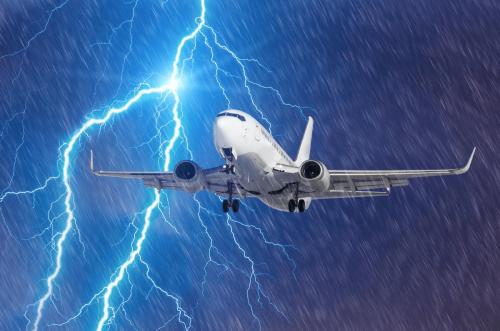Understanding All About Flight Turbulence

You must have made an online flight ticket booking and traveled in a plane to your destination. As passengers, we have all experienced that sudden jolt and the feeling of weightlessness when an airplane hits a patch of turbulence. It can be a nerve-wracking experience, causing anxiety and discomfort for even the most seasoned travelers. However, understanding the science behind air turbulence can help demystify this phenomenon and provide insights into its causes, types, and the measures in place to ensure passenger safety.
What is Air Turbulence?
Air turbulence refers to the sudden and often unpredictable changes in airflow that an aircraft experiences during flight. These changes in airflow can lead to erratic movements, bumps, and vibrations that are felt by both passengers and crew on board. While turbulence can be unsettling, it's important to note that modern aircraft are designed and built to withstand the forces generated by most types of turbulence.
Causes of Air Turbulence
Clear Air Turbulence (CAT): One of the most common types of turbulence, CAT occurs in clear skies without any visible signs of clouds. It is often found at high altitudes, typically above 25,000 feet. CAT is caused by wind shears, which are sudden changes in wind speed and direction at different altitudes. These wind shears can result from the interactions between different air masses, jet streams, and atmospheric pressure systems.
Mountain Wave Turbulence: When air flows over mountain ranges, it can create wave-like patterns of alternating rising and sinking air. This phenomenon, known as mountain wave turbulence, occurs on the lee side of the mountains and can result in severe turbulence that can extend for hundreds of miles downwind. Mountain wave turbulence can be encountered at various altitudes, depending on the size and shape of the mountain range. Typically, it is most pronounced at higher altitudes, such as during cruise flight. However, it can also occur at lower altitudes, especially during the approach and departure phases of flight.
The severity of mountain wave turbulence can vary, ranging from mild to severe. In some cases, it can cause significant discomfort to passengers and crew, as well as potential stress on the aircraft structure. Therefore, pilots are trained to be aware of the potential for mountain wave turbulence and take appropriate measures to mitigate its effects.
Frontal Turbulence: Frontal boundaries between different air masses can also lead to turbulence. When a warm air mass meets a cold air mass, the boundary between them can be turbulent as the two masses try to mix. This is common in areas with rapidly changing weather conditions. When a warm air mass and a cold air mass collide, they create a boundary known as a front. As the air masses interact, they can cause turbulence due to the differences in temperature, humidity, and wind speed between the two air masses. The turbulence associated with weather fronts can be quite turbulent and unpredictable, making it important for pilots to be aware of its potential presence.
Convective Turbulence: Convective turbulence is often associated with thunderstorms and occurs when warm, moist air rises rapidly into cooler altitudes. This vertical movement of air can create pockets of turbulence within the storm clouds, which can be particularly intense and hazardous for aircraft.
Types of Turbulence
Light Turbulence: This type of turbulence is often described as minor bumps and can be compared to driving on a slightly bumpy road. It may cause a slight discomfort but is generally not a cause for concern.
Moderate Turbulence: Moderate turbulence can be more noticeable, causing drinks to spill and unsecured objects to move. However, aircraft are designed to handle this level of turbulence without any significant risk to safety.
Severe Turbulence: Severe turbulence is characterized by sudden and violent jolts, which can result in passengers and unsecured items being thrown around the cabin. Despite its intensity, severe turbulence is rare and aircraft are built to withstand its forces.
Passenger Safety Measures
Ensuring the safety of passengers and crew is the top priority of any airline. Modern aircraft are equipped with advanced technology that helps pilots anticipate and navigate through turbulent areas. Some of these measures include:
Weather Radar: Aircraft are equipped with weather radar systems that allow pilots to detect areas of potential turbulence and avoid them whenever possible.
Turbulence Reports: Pilots routinely share information about turbulence encounters with air traffic control and other aircraft in the vicinity. This information helps other pilots adjust their routes to avoid turbulent areas.
Seatbelt Signs: Passengers are required to keep their seatbelts fastened whenever they are seated, even if the seatbelt sign is turned off. This precautionary measure helps prevent injuries during unexpected turbulence.
Pilot Expertise: Pilots undergo rigorous training to handle various flight conditions, including turbulence. Their experience and expertise play a crucial role in ensuring a smooth and safe flight.
Conclusion
Air turbulence, while often anxiety-inducing, is a natural and common occurrence in aviation. It is caused by a variety of factors such as wind shears, atmospheric pressure systems, and interactions between air masses. Understanding the different types of turbulence and the safety measures in place to mitigate its effects can help passengers feel more at ease during their flights. As technology continues to advance, airlines and pilots are better equipped than ever to navigate through turbulent areas and ensure the safety and comfort of everyone on board. So, the next time you feel that bump during your flight, remember that it's just another aspect of the fascinating science of aviation.
Post Your Ad Here

Comments